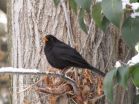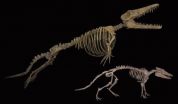(Press-News.org) Faced with the same threat, city and country birds do not react in the same way despite being from the same species. According to a new study, urban birds have changed their anti-predator behaviour in new environments.
When a bird is faced with a predator, its only objective is to escape. However, city birds do not react in the same way as their countryside counterparts, despite being from the same species. Urbanisation plays an influential role in their survival strategies.
To study this phenomenon, Juan Diego Ibáñez-Álamo, researcher at the University of Granada (UGR) and Anders Pape Møller from Paris-Sud University (France) analysed the escape techniques of 1,132 birds belonging to 15 species in different rural and urban areas.
Published in the Animal Behaviour journal, the results show that city birds have changed their behaviour to adapt to new threats like cats (their main predator in the city) instead of their more traditional enemies in the countryside, such as the sparrow hawk.
"When they are captured, city birds are less aggressive, they produce alarm calls more frequently, they remain more paralysed when attacked by their predator and they loose more feathers than their countryside counterparts," as explained to SINC by Juan Diego Ibáñez-Álamo.
The surprising thing is that urbanisation is directly linked with these differences, which become more acute the earlier the former has taken place. This suggests that escape strategies evolve alongside the expansion of cities; a concept that is on the increase worldwide.
Adapt or die in the territory of man
Like the habitat of many animals and plants, the habitat of birds changes and fragments. Discovering how they adapt to transformations in their habitat is "crucial" for understanding how to lessen their effects. "Predation change caused by city growth is serious," outlines Ibáñez-Álamo.
As the scientist indicates, tactics against their hunters are "crucial" so that birds can adapt to their new environment: "Birds should modify their behaviour to be able to survive in cities because if not, they will become extinct at the mercy of urban growth."
INFORMATION:
References:
Møller, A. P.; Ibáñez-Álamo, J. D. "Escape behaviour of birds provides evidence of predation being involved in urbanization" Animal Behaviour 84(2): 341-348 DOI: 10.1016/j.anbehav.2012.04.030, 2012.
City birds adapt to their new predators
2012-11-07
ELSE PRESS RELEASES FROM THIS DATE:
Ultrasensitive photon hunter
2012-11-07
Fast and ultrasensitive optical systems are gaining increasing significance and are being used in a diverse range of applications, for example, in imaging procedures in the fields of medicine and biology, in astronomy and in safety engineering for the automotive industry. Frequently the challenge lies in being able to record high-quality images under extremely low light conditions. Modern photo detectors for image capture typically reach their limits here. They frequently work with light-sensitive electronic components that are based on CMOS (Complementary Metal Oxide ...
Dealing with power outages more efficiently
2012-11-07
Power supply is the backbone of our modern economy. Nearly every aspect of life depends on electrically-operated devices. When the flow of power stops, it is not just the lights that go out. In the supermarket, the automatic teller machines and cash registers stop working. Even telephones, radios and televisions become paralyzed. If the shortage lasts a long time the supply of hot water, gas and fuel and the functioning of respirators at intensive care units in nursing homes or at private homes is at risk.
The causes of this dreadful scenario can range from natural disasters ...
Activating the 'mind's eye' -- sounds, instead of eyesight can be alternative vision
2012-11-07
Jerusalem, Nov. 7, 2012 -- Common wisdom has it that if the visual cortex in the brain is deprived of visual information in early infanthood, it may never develop properly its functional specialization, making sight restoration later in life almost impossible.
Scientists at the Hebrew University of Jerusalem and in France have now shown that blind people – using specialized photographic and sound equipment – can actually "see" and describe objects and even identify letters and words.
The new study by a team of researchers, led by Prof. Amir Amedi of the Edmond and ...
Protected areas in East Africa may not be conserving iconic plants
2012-11-07
A new study led by researchers from the University of York suggests protected areas in East Africa are not conserving plants such as the iconic Acacia tree.
Acacia, the thorny flat-topped tree that characterises the African savannas, is an important component of ecosystem diversity. However, the researchers found that the majority of Acacia biodiversity 'hotspots' receive little protection through the protected area network, which includes national parks, nature and forest reserves. The situation, they say, may be exacerbated by climate change.
The results of the study, ...
Development of measures to prevent wine indispositions
2012-11-07
Biogenic amines may be one of the factors responsible for symptoms such as headaches, gastro-intestinal disorders, shortness of breath, fall in blood pressure, and even unconsciousness and cardiac arrhythmia in severe cases. Histamine, one of the best known members of this group, can cause serious physical problems. Biogenic amines can be produced in the body by natural metabolic activities but are also ingested in larger quantities with food. They play a special role in microbiologically produced food such as wine, beer, cheese, and sauerkraut. In a joint project Johannes ...
Recent studies bring fossils and genes together to piece together evolutionary history
2012-11-07
Paleontology, with its rocks and fossils, seems far removed from the world of developmental genetics, with its petri dishes and embryos. Whereas paleontology strives to determine "What happened in evolution?", developmental genetics uses gene control in embryos to try to answer "How did it happen?" Combined, the two approaches can lead to remarkable insights that benefit both fields.
In the current issue of the Journal of Vertebrate Paleontology, Hans Thewissen, Ingalls-Brown Professor at Northeast Ohio Medical University (NEOMED), and his colleagues review recent studies ...
New method could help communities plan for climate risk
2012-11-07
CAMBRIDGE, Mass. -- Climate scientists cannot attribute any single weather event — whether a drought, wildfire or extreme storm — to climate change. But extreme events, such as Hurricane Sandy, are glimpses of the types of occurrences the world could be more vulnerable to in the future. As the devastation left by Sandy continues to reverberate, decision-makers at every level are asking: How can we be better prepared?
MIT researchers have developed a new tool to help policymakers, city planners and others see the possible local effects of climate change. Its regional projections ...
Synthetic biofilter wins through to the top 'Sweet 16' in Boston
2012-11-07
This press release is available in German.
Months of painstaking work in the laboratory at Bielefeld University's Center for Biotechnology (CeBiTec) have paid off: the 15 students participating in this year's 'international Genetically Engineered Machine competition' (iGEM) at the Massachusetts Institute of Technology (MIT) have good reason to celebrate. The goal of their project was to develop a biological filter that removes estrogen from drinking water. It was a success: they managed to produce enzymes that break down the hormone. On Monday 5 November, the competition ...
Longer use of hormonal contraception during midlife predicts better cognitive function later
2012-11-07
New Rochelle, NY, November 7, 2012—Premenopausal use of hormonal contraceptives may improve the cognitive abilities of women in midlife and for years afterward. This finding may have implications for prevention of declining cognitive function that occurs with advancing age and in diseases such as Alzheimer's. The beneficial effects of hormones increase the longer a woman uses them, as described in a study published in Journal of Women's Health, a peer-reviewed publication from Mary Ann Liebert, Inc., publishers. The article is available free on the Journal of Women's Health ...
Teva to present new Phase III data for QNASL® Nasal Aerosol at the 2012 ACAAI Meeting
2012-11-07
Contact: Denise Bradley
denise.bradley@tevapharm.com
215-591-8974
Teva North America
Teva to present new Phase III data for QNASL® Nasal Aerosol at the 2012 ACAAI Meeting
Studies highlight safety and efficacy profiles in pediatric patients with seasonal allergic rhinitis, reinforce device functionality and reliability and demonstrate ocular safety profile
JERUSALEM, Israel, November 6, 2012 – Teva Pharmaceutical Industries Ltd. announced today that additional data from the Phase III clinical program for QNASL® (beclomethasone dipropionate) Nasal Aerosol will be ...






